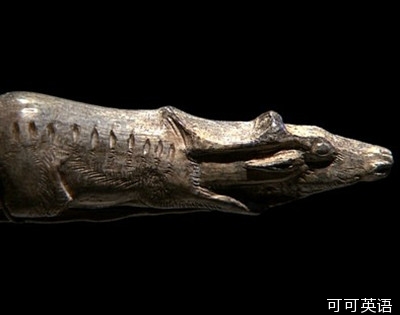The larger, male reindeer displays an impressive set of antlers, which run along almost the whole length of his back, and we can sex him quite confidently as the artist has carved his genitals under his belly. The female has smaller antlers and four little bumps on her underside that look just like teats.
體型較大的雄鹿展現出一對令人印象深刻的鹿角,長度幾乎延伸完它整個后背,而且通過藝術家雕刻在它腹部下邊的生殖品也可以清晰判斷出它的性別。母鹿鹿角較小,而且腹部下邊四個小凸起似乎就是四個奶嘴。
But we can be much more specific than this even, because we're clearly looking at these animals in the autumn, at the time of rutting and migration to winter pastures. Only in the autumn do both male and female have full sets of antlers and coats in such wonderful condition.
我們還可以更進一步地具體描繪,顯然我們觀察到的是秋天時向冬季牧地進行大遷移的馴鹿。因為也只有在冬天,雌雄馴鹿同時長有鹿角,而且擁有如此光澤油亮的好皮毛。
On the female's chest, the ribs and the sternum have been beautifully carved. This object was clearly made not just with the knowledge of a hunter but also with the insight of a butcher, someone who not only looked at his animals, but cut them up.
雌鹿的胸部部位上,肋骨民胸骨雕刻得精致傳神。顯然制作這件藝術品的人,不僅僅擁有獵人的知識,還擁有屠夫的見識;不僅僅觀察過這些動物,而且屠宰過。
By an astonishing stroke of luck, we know that this detailed naturalism was only one of the styles that Ice Age artists had at their disposal.
通過極妙的機緣巧合,我們認識到這種細節逼真的自然主義風格僅僅冰河時代藝術家們進行藝術創造的眾多風格之一。
In the case next to the reindeer, the British Museum shows another sculpture found in that same cave at Montastruc.
在馴鹿雕塑品旁邊的展位臺上,顯現的是大英博物館的另一件同是出土于 Montastruc河畔的雕塑品。
By happy symmetry, where our reindeer are carved on mammoth tusk, the other sculpture shows a mammoth carved on a reindeer antler.
可喜可嘆的是,我們剛剛談論的是一對馴鹿雕刻在猛犸象牙上,那另一件雕塑品卻是一頭猛犸象雕刻到馴鹿鹿角上。
But the mammoth, although instantly recognisable, is drawn in a quite different way - simplified and schematised, somewhere between a caricature and an abstraction, and this is no one-off accident; Ice Age artists display a whole range of artistic styles and techniques: abstract, naturalistic, even surreal - as well as using perspective and sophisticated composition. These are modern humans with modern human minds, just like our own. They still live by hunting and gathering, but they're interpreting the world through art. So what's driving this?
然而即使這猛犸象即使形象可以馬上識別,展示的藝術手法卻迥然不同,更加的簡化、更加的速寫,介于一種漫畫與抽象畫之間。這事實也絕非是一種偶然性,冰何時代藝術家們顯示出豐富多樣的藝術風格與技巧:抽象的、自然的、甚至是超現實的,還有使用角度因素與復雜的各種組合。這些人類已經是擁有現代頭腦的現代人,就跟我們自己一樣。他們的生存方式仍舊是狩獵與采集,然而他們已經通過藝術來詮釋世界。那么,究竟是什么力量在驅動這些?
'I think what probably happens - around 100,000 years ago - is different bits of the brain get connected together in a new way, and they can combine different ways of thinking.
“我覺得大約十萬年前,可能我們頭腦的不同部位以一種嶄新的方式連接了起來,使得人類開始可以結合不同思維方式進行思考。”
So they can combine what they know about nature with what they know about making things, and this gives them a new capacity to produce pieces of art.
“因此,他們能夠把自己對大自然的認知結合到制造物品的知識中去,從而給予了他們創造藝術品的新能力。
But also I think those Ice Age conditions were critical as well. That was a very challenging time for people living in harsh, long winters - the need to build up really intense social bonds, the need for ritual, the need for religion, I think is all related to this flowering of fantastically creative art at the time.
但我認為當時冰河時代的客觀條件也是極為關鍵的。當時對于要渡過惡劣而漫長冬季的人類而言,那是一段非常具有挑戰性的歲月,從而他們延伸出建立非常親密的社交紐帶的渴望、祭祀的需求、宗教的需求;我認為這一切都與同時期,如此多的創造性藝術極戲劇化的如燦爛繁花般涌現有關。












